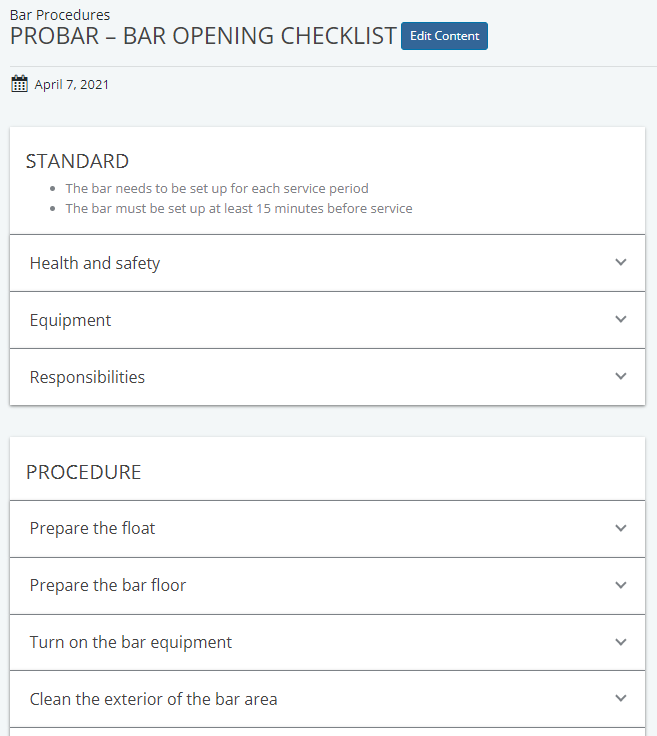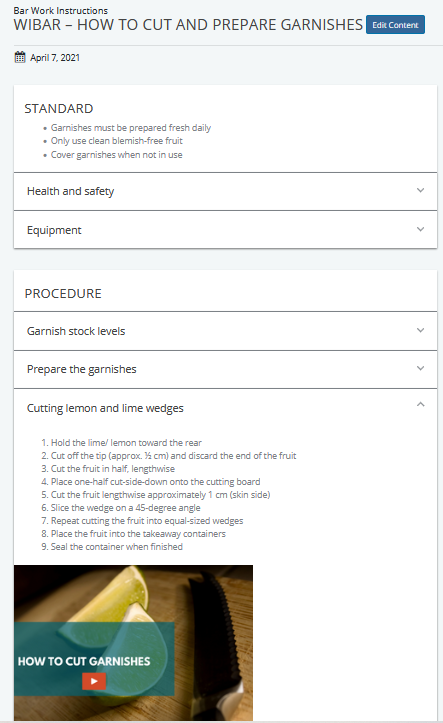Your Operations Procedures are your businesses most important working documents, but too often they are missing, poorly written or just left unused on a shelf.
In this article, we will show you a simple and effective way to write your own Standard Operating Procedures (SOP), that you can use to improve your team's quality, consistency and efficiency of service.
Why you need written standards
It doesn’t matter if you call it the SOP, Operations Manual or an Employee Instruction Guide, if you don’t have your procedures written down, how will your team know what to do to ensure that each customer gets a consistently great experience?
Your written standard demonstrates to employees what to do and how to do it.
AskManual
Check out the online procedures and training portal designed for hospitality
The benefits of having written procedures
A written procedure is more than a document showing someone how to set a table, use a till or what they need to do to close the venue at the end of the day.
When written properly and used your standard operating procedures can be used to:
- improve quality and consistency
- deliver training that gets better results
- create accountability for all team members
- assess each employee’s ability to do their job
- reduce lost time and cost due to rework and mistakes
- correct performance issues based on the business standards
- enable management to spend more time building the business
The challenges with writing procedures
There are several challenges each business will face when writing their Standard Operating Procedures these are
- Time - Writing procedures take a long time, as it requires team members to write each task down, step by step, take photos, get each procedure checked and finally printed.
- Writing skills - Writing procedures require someone to be able to break down each task into simple to understand steps, and then list the steps down so they can be easily followed but also provide adequate information for the employees.
- Changing procedures - As your business evolves and changes with the implementation of new processes, tools, equipment, and technology, you need to ensure that your procedures change with them.
Be prepared that writing your Standard Operating Procedures from scratch can take months if not years, but if you prioritise them based on your needs and complete them one task at a time, they will earn their value tenfold.
The risk of buying off the shelf standards
Buying cheap standards documents off the internet can be more hassle than they are worth because they are often vague and poorly written, if they come as PDF files they can't be edited, and if they can be edited you still need to spend the time and effort to make them specific to your venue.
How to create your service standards
The easiest way to write your Standard Operating Procedures is to break them down into three key parts:
- Job – A set of work-based activities that need to be completed (i.e. open procedures, service procedures, closing procedures).
- Procedure – A list of the different steps (tasks) required to complete a job
- Work instruction – The step-by-step how-to guide that tells the employee how to complete each task.

You need to write as many 'Work Instructions' as you have 'Tasks' that have complex instructions that need to be followed.
How to write jobs & procedures
Involve your team members to help with writing the procedures.
- Write a list of all the different jobs that need to be done (i.e. open procedures, service procedures, closing procedures)
- Select one job at a time
- Use Post-it notes to write down the different procedures (tasks) that need to be done to complete the job
- Rearrange the Post-it notes in order of sequence of importance
- Write the sequence of procedures down
- Add some simple instructions under each procedure
- Write a work instruction for each complex procedure
Your procedures can be used as or to write a more specific checklist

Sample Procedures List - AskManual.org
How to write work instructions
Your work instructions are specific guides on how to complete each task. How many Work Instructions and how in-depth they are will depend on how complex the task is.
When writing work instructions
- Write each step onto a post It note
- Arrange each step in order
- Write the sequence of steps down using action statements (i.e. Pour cold milk into the jug until it is ¾ full, Ask the customer if they have made a booking, Enter the order into Micros etc)
- Add a high quality image or photo of each key stage and the end product
- Get key team members to check and give feedback
- Share the procedure with the team

Sample Work Instruction - AskManual.org
So there we have it, How to write standard operating procedures that work. Without written procedures, you cannot expect your team to consistently deliver a great product or service.

You can also use your procedures to train, assess and correct employees’ knowledge and skills to meet the standards of the business.
WHAT ARE YOUR THOUGHTS? DO YOU AGREE, OR DO YOU HAVE A DIFFERENT PERSPECTIVE?
If so, then leave your comments and feedback below
AskManual
The Online procedures and training portal designed for hospitality

